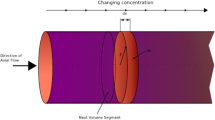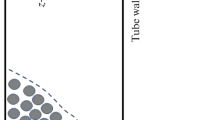Abstract
In this research, the performance of the innovative non-ideal models for catalytic plug reactor design based on the oxidative coupling of methane (OCM) process was investigated. Using plug flow reactors (PFR) and continuous stirred tank reactors (CSTR), parallel (Model 1) and consecutive (Model 2) reactors in series were proposed. The models were validated based on experimental data from an OCM over La2O3/CaO catalyst in a fixed-bed reactor. The results from both models were in good agreement with the experimental data, while model 2 slightly outperformed model 1 compared to both. Moreover, the sensitivity of non-ideal models was investigated and compared with the results obtained from the ideal simulation model. The influence of the temperature and methane-to-oxygen (CH4/O2) ratio on the process performance was evaluated. OCM reactions showed better performance with increasing CH4/O2 ratios than temperature augmentation. The yield, selectivity, and conversion reached their maximum values at 1103 K, and with the increase in temperature, increasing and decreasing trends were observed. With a maximum error of 2.6%, the accuracy of the non-ideal models was better than that of the ideal model. It resulted in the finding that the proposed non-ideal modeling of reactors was useful for monitoring and supervising OCM processes.











Similar content being viewed by others
Data Availability
The data in this article is taken from the references mentioned in the article, and the references are available.
References
J. Boudrant, Advances in Biochemical Engineering, ed. By T.K. Ghose, A. Fiechter, N. Blakebrough (Adv. Biochem. Eng. Biotechnol., 1st ed., Springer Berlin, Heidelberg, heidelberg, 1979) p. VII. https://doi.org/10.1007/3-540-08557-2
O. Levenspiel, Chemical Reaction Engineering, 3rd Edition | (Wiley, New York, 1998), pp. 704. https://www.wiley.com/en-us/Chemical+Reaction+Engineering%2C+3rd+Edition-p-9780471254249. Accessed 13 March 2023
D.E. Swaine, A.J. Daugulis, Biotechnol. Prog. 4, 134 (1988). https://doi.org/10.1002/BTPR.5420040304
S. Fogler, Chapter 9: Multiple Reactions, in: Elem. Chem. React. Eng., 2nd ed. (Prentice Hall International, New Jersey, 1992)
R. Perry, D.W. Green, Perry’s Chemical Engineers’ Handbook, 7th edn. (McGraw Hill, New York, 2006)
J.C. Merchuk, Tower reactor models, Measuring, Modelling and Control, ed. By H.J. Rehm, G. Reed (Biotechnology, K. Schiige, VCH, Weinheim, 1991), p. 349
P.R. Fields, N.K.H. Slater, Chem. Eng. Sci. 38, 647 (1983). https://doi.org/10.1016/0009-2509(83)80124-9
H.J. Warnecke, J. Prüss, H. Langemann, Chem. Eng. Sci. 40, 2321 (1985). https://doi.org/10.1016/0009-2509(85)85135-6
H.J. Warnecke, J. Prüss, L. Leber, H. Langemann, Chem. Eng. Sci. 40, 2327 (1985). https://doi.org/10.1016/0009-2509(85)85136-8
R. Van der Lans, Hydrodynamics of a bubble column loop reactor (Delft University of Technology, 1985). https://www.narcis.nl/publication/RecordID/oai:tudelft.nl:uuid:33d1d9d9-0cd9-455e-87b5-18606319974d. Accessed 14 March 2023
P. Verlaan, Modelling and characterization of an airlift-loop bioreactor (Wageningen University and Research, 1987). https://search.proquest.com/openview/f19f47ff7e03090ad9cfc9839b898121/1?pq-origsite=gscholar&cbl=2026366&diss=y. Accessed 14 March 2023
D. Wolf, W. Resnick, Eng. Chem. Fundam. 2, 287 (1963). https://doi.org/10.1021/I160008A008/ASSET/I160008A008.FP.PNG_V03
V.G. Levich, V.S. Markin, Y.A. Chismadzhev, Chem. Eng. Sci. 22, 1357 (1967). https://doi.org/10.1016/0009-2509(67)80026-5
V.J. Davidson, D. Paton, L.L. Diosady, W.A. Spratt, J. Food Sci. 48, 1157 (1983). https://doi.org/10.1111/J.1365-2621.1983.TB09181.X
A.I. Yeh, Y.M. Jaw, J. Food Eng. 39, 81 (1999). https://doi.org/10.1016/S0260-8774(98)00150-2
P. Małoszewski, P. Wachniew, P. Czupryński, J. Hydrol. 331, 630 (2006). https://doi.org/10.1016/J.JHYDROL.2006.06.014
C.G.C.C. Gutierrez, E.F.T.S. Dias, J.A.W. Gut, J. Food Eng. 98, 248 (2010). https://doi.org/10.1016/J.JFOODENG.2010.01.004
S. Erdogan, M. Wörner, H.S. Soyhan, Chem. Eng. J. 200–202, 380 (2012). https://doi.org/10.1016/J.CEJ.2012.06.062
G. Haarlemmer, T. Bensabath, Comput. Chem. Eng. 84, 281 (2016). https://doi.org/10.1016/J.COMPCHEMENG.2015.08.017
A. Donoso-Bravo, C. Sadino-Riquelme, D. Gómez, C. Segura, E. Valdebenito, F. Hansen, Bioresour. Technol. 260, 95 (2018). https://doi.org/10.1016/J.BIORTECH.2018.03.082
R. Fazli-Abukheyli, P. Darvishi, Chem. Eng. Sci. 195, 531 (2019). https://doi.org/10.1016/J.CES.2018.09.052
A.B. Smith et al., Kinetics of oxidative coupling of methane over lithium-cerium oxide catalysts. J. Catal. 152(1), 220–229 (1995)
X. Liu et al., Kinetics of oxidative coupling of methane: a combined experimental and modeling study. J. Catal. 209(1), 92–102 (2002)
Y. Zhao, D.G. Truhlar, Theoretical studies of the oxidative coupling of methane on oxide surfaces: mechanism and kinetics. Chem. Soc. Rev. 35(10), 815–828 (2006)
H. Zhu et al., Density functional theory study of oxidative coupling of methane on metal oxide catalysts. J. Catal. 261(1), 76–85 (2009)
Y. Li et al., A microkinetic model for oxidative coupling of methane on CeO2. J. Catal. 317, 174–183 (2014)
B. Wang et al., Microkinetic modeling of oxidative coupling of methane on PrOx catalysts: effect of H2O, CO2, and catalyst deactivation. J. Catal. 346, 114–125 (2017)
S. Chen et al., Computational fluid dynamics simulation of oxidative coupling of methane in microchannel reactor. Ind. Eng. Chem. Res. 57(38), 12666–12675 (2018)
Y. Zhang et al., Artificial neural network-based prediction of oxidative coupling of methane process over La-promoted SrTiO3 catalysts. Chem. Eng. J. 382, 122862 (2020)
L. Xu et al., Optimization of catalyst composition and reaction conditions for oxidative coupling of methane via a genetic algorithm combined with machine learning. Chem. Eng. Sci. 254, 116282 (2022)
R.B. Mac Mullin, Trans. Am. Inst. Chem. Eng. 31, 409 (1935). https://ci.nii.ac.jp/naid/10006949796/. Accessed 14 March 2023
P.V. Danckwerts, Chem. Eng. Sci. 2, 1 (1953). https://doi.org/10.1016/0009-2509(53)80001-1
Z. Stansch, L. Mleczko, M. Baerns, Ind. Eng. Chem. Res. 36, 2568 (1997). https://doi.org/10.1021/IE960562K
C.T. Tye, A.R. Mohamed, S. Bhatia, Chem. Eng. J. 87, 49 (2002). https://doi.org/10.1016/S1385-8947(01)00191-7
Author information
Authors and Affiliations
Corresponding author
Ethics declarations
Conflict of interest and authorship conformation
Please check the following as appropriate:
All authors have participated in (a) conception and design, or analysis and interpretation of the data; (b) drafting the article or revising it critically for important intellectual content; and (c) approval of the final version.
This manuscript has not been submitted to, nor is under review at, another journal or other publishing venue.
The authors have no affiliation with any organization with a direct or indirect financial interest in the subject matter discussed in the manuscript
The following authors have affiliations with organizations with direct or indirect financial interest in the subject matter discussed in the manuscript:
Rights and permissions
Springer Nature or its licensor (e.g. a society or other partner) holds exclusive rights to this article under a publishing agreement with the author(s) or other rightsholder(s); author self-archiving of the accepted manuscript version of this article is solely governed by the terms of such publishing agreement and applicable law.
About this article
Cite this article
Ghareghashi, A., Ghader, S. Investigation of non-ideal model for Oxidative Coupling of Methane reactor using proposed ideal reactor arrangement. emergent mater. 6, 1651–1663 (2023). https://doi.org/10.1007/s42247-023-00540-w
Received:
Accepted:
Published:
Issue Date:
DOI: https://doi.org/10.1007/s42247-023-00540-w




